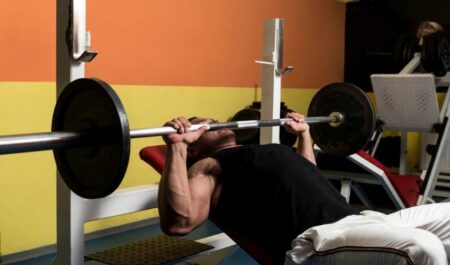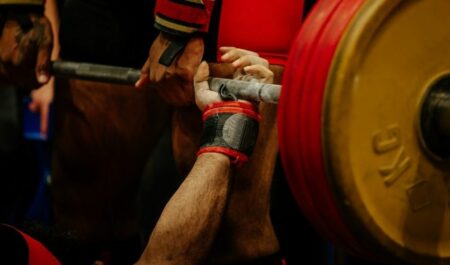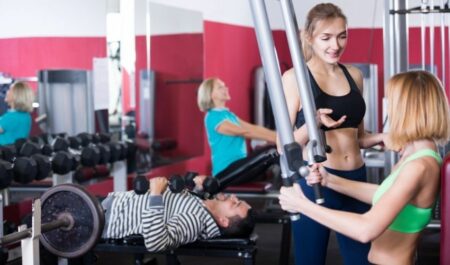The reverse grip bench press workout is a great upper chest workout. It targets and engages more muscles than the normal bench press workout. In fact, it is considered the most effective upper chest workout. Unlike in the standard bench press, in a reverse grip, your palms should face you while you hold and lift the weights. This grip locks your elbows and engages more muscles as you lift the weights.
It is important to ensure that your thumbs are fully wrapped around the bar at all times throughout the exercise. If done with your thumbs and fingers, the exercise would be too dangerous as you risk losing grip on the weights.

This article explores the different variations of the reverse grip bench press workout. It educates you on the safest and most effective ways to complete the exercise. It aims at helping you achieve the best results with this workout.
What Is The Reverse Grip Bench Press Workout?
The reverse grip bench press is specially designed to target and develop your upper chest muscles. You can complete the exercise with a barbell or a pair of dumbbells. Regardless of the weights, you choose you will achieve your goal.
There are many variations of this exercise especially when you use dumbbells. It is why dumbbells are widely preferred over the barbell. The reverse grip curls, for example, work on your biceps and brachialis muscles.
For the reverse grip curls, you can use either a barbell or a pair of dumbbells. The exercise functions to give you a bigger, more pronounced arm structure. It also improves your grip and relieves elbow pain.
Always pay attention to the path of motion while doing the reverse grip bench press workout. Lift the weights from below your chest then complete an ascending motion in an arch.
The Benefits Reverse Grip Bench Press?
The reverse grip bench press is an exceptional exercise for your shoulder and chest muscles. Unlike other exercises that target this area, the reverse grip ensures that your elbows are tucked during the workout. As such, the flip on the grip protects your shoulder joints from injury.
The flip also makes it possible to do the exercise even with shoulder pain. A good example of this would be David Paul. He is American weight lifter who, due to a shoulder injury, could not perform the regular bench press.
However, Paul managed to handle 550 pounds of resistance when he tried the reverse grip bench press.

From this case, it is evident that the reverse grip gave Paul’s shoulder a stronger position. After making full recovery Paul only managed to lift 520 pounds while performing the regular bench press.
What Safety Of Reverse Grip Bench Press Can Expect?
There are several pointers you need to watch out for when starting the reverse grip bench press exercise. These include:
- Always ensure that your thumbs are fully wrapped around the bar at all times throughout the exercise. While doing the standard bench press, some weightlifters place their fingers and thumbs on the same side. That grip can be very dangerous when doing the reverse grip version of the exercise.
- Always maintain slow and controlled movements. Never bounce the barbell off your chest. Doing the exercise in that manner could be counterproductive, thus poorly engaging the targeted muscles. Besides, it could lead to major injuries.
- This workout targets your upper chest and triceps. To maximize the action, do it with other upper-pec exercises like the reverse grip pull-down and reverse grip lat pull-down. These two are also great for your forearms and biceps
- Feeling a lack of flexibility in your wrists and forearms is quite normal as you start. Your forearms and wrists should adapt to the change in grip as you take on heavier weights during warm up.
- If the workout feels a bit awkward for you, you may want to start working out on a Smith machine first.
Muscle and Fitness Reverse Grip Bench Press
Many people who execute bench press exercises tend to complain about shoulder pain. To get around the problem, just flip your arms around the barbell so that you do the reverse grip bench press instead. It takes the weight off your shoulders and gives you better control over the movements.
You should be doing your reverse grip bench press early in your upper body workout. It is a rigorous and strenuous exercise. As such, it would be best to get it over with before you get too tired. Doing it early also ensures that you are fresh and strong enough to do it right for the best results.
The reverse grip bench press targets your pecs and triceps. It also works to make your back, biceps, and forearms stronger. Using the reverse grip puts more stress on your biceps and forearms, which in turn increases your lower back’s stability.
As you get better at this workout you can gradually increase the number of sets you do per workout as well as the number of reps per set. For the best results, aim for 3-4 sets per workout and 8-10 rep per set.
What Age Group More Effective?
The exercise may appear to be more effective in people aged between 25 and 35 years. A reverse grip overhead press workout enunciates the results even more. However, the fact is that this age group is quite strong and still young, so they have the luxury to give their all to the workout.
It is not advisable for children younger than 17 years to perform the reverse grip bench press. Those between the age of 17 and 25 can do the workout, but their results won’t be as pronounced as those of people between 25 and 35.
The workout appears to be very effective in over 35-year olds who have been doing the exercise long before hitting 35.

People older than 35 years are also likely to gain the most from this exercise depending on their dedication. However, their results might not be as pronounced as those of their younger counterparts.
Reverse Grip Bench Press Upper Chest Workout 12
The reverse grip targets your upper pecs. It focuses on your clavicular head. The pressure to your triceps is higher in a reverse grip as compared to the standard press. The grip also engages the biceps to stabilize your motions.
Since muscle activity measures the number of muscle fibred engaged in a particular exercise, reverse grip bench presses are considered superior to incline bench presses. The reverse grip bench press targets and engages more muscles in your upper chest.
To achieve the best results in your upper pecs complete 3-4 sets of reverse grip bench presses. Complete between 8 and 12 reps per set. For maximum results incorporate the reverse grip tricep extension into your upper chest work out sessions.
Reverse Grip Dumbbell Bench Press Workout
The reverse grip dumbbell bench press workout is similar to the standard dumbbell bench press except with an underhand grip. There are important tips to help you execute this workout like a professional for maximum effectiveness. These are:
- When using heavy dumbbells you may find it effective to push the weights with your thighs.
- You need to be mentally and physically sharp for this exercise. Don’t allow the dumbbells to touch during the exercise, especially not at the top of each rep.
- Control your motion with a slower lowering movement as compared to the lifting movement.
- Lower the dumbbells completely before doing the next rep to ensure full-range motion.
Reverse Grip Barbell Bench Press Workout
As the name suggests, the reverse grip barbell bench press workout is similar to the standard bench press except with an underhand grip. For the best results include a reverse grip barbell row exercise chest and shoulder workouts. It has a direct focus on your biceps and lats.
Exercise Details
- Difficulty Level: Advanced
- Muscles Worked: Pecs, delts, and triceps
- Equipment: Barbell, Bench
- Type: Strength
The two main steps to completing this exercise are detailed below.
Step 1: Lay down with your back pressed flat against the bench. Using an underhand grip, grab the barbell. Maintain your arms at a shoulder-width distance apart. Bring the barbell right above your chest and extend your arms completely.
Step 2: Keep your mind sharp and your muscles focused. Bring the barbell down to your chest in a slow controlled movement. Let it touch your chest. Take a short pause before pressing the bar back up into the starting position to repeat the exercise.
Reverse Grip Decline Bench Press
Exercise Details
- Difficulty Level: Intermediate
- Muscles Worked: Chest, shoulders, triceps
- Equipment: Barbell, Bench
- Type: Strength
Listed below are the steps to follow while performing the workout.
Step 1: Position yourself on a decline bench. Your back should be flat against the bench and your feet placed below the pads. Use a reverse grip to hold the barbell with your arms shoulder width apart.
Step 2: Using slow moderated movements, push the barbell straight over your chest with a reverse grip overhead press. Simultaneously squeeze your pecs and pause for a few seconds.
Step 3: Get back to the initial position
Step 4: Repeat the movement for several reps and sets.
Reverse Grip Incline Bench Press
Exercise Details
- Level of Difficulty: Advanced
- Muscles Involved: Chest, Triceps, Deltoids
- Equipment: Bench, Barbell
- Target: Strength
There are two main steps to completing this exercise.
Step 1: Adjust the angle of the incline bench anywhere between 30 and 45 degrees depending on the angle most comfortable for you. Station yourself on the incline bench.
Using a reverse grip, grab the barbell with your hands shoulder width apart. Hold the barbell above your chest and push your arms upward like you are doing reverse grip pushups. The movement should lock your elbows.
Step 2: Use a slow controlled motion to lower the barbell directly to your upper chest. Break for a few seconds before repeating step one.
Conclusion
The reverse grip bench press workout is far much superior to other upper chest workouts. It targets the highest number of your upper chest and shoulder muscles. To achieve the best results, combine various variations of the workout and interchange them in different workout sessions.
The most important thing is to adhere to all the safety measures to avoid injuries. Aside from that, it is very important to check your diet and maintain sufficient protein consumption.
You cannot build muscles effectively without proper protein intake. The best source of protein for your muscles would be protein shakes.
That said; follow all the instructions to make sure that you are doing your workouts accurately. Otherwise, you may risk tearing your muscles or growing some muscles more than others. You do not want to have muscle imbalances.
